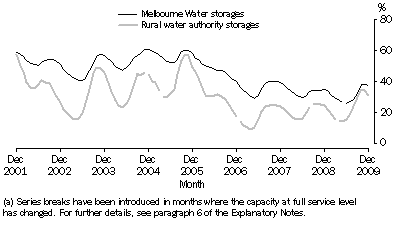WATER RESOURCES
At the end of December 2009, Victoria's water storages were at 30.3% of their capacity at full service level of 14,020 GL. This was 2.9 percentage points lower than the level in November 2009, and 6.2 percentage points higher than in December 2008.
Melbourne's water storage level at the end of December 2009 was 37.5% of capacity. This was 0.5 percentage points lower than in November 2009 and 2.6 percentage points lower than in December 2008. Rural water storages held 31.2% of their capacity at the end of December 2009, 2.7 percentage points lower than in November 2009, and 7.0 percentage points higher than the level in December 2008.
Between December 2008 and December 2009, the volume of water held in rural water storages increased by 24.1%. Almost half (49.9%) of this increase was captured in Lake Eildon in the Goulburn basin, with a further one third (34.6%) of the increase being in Murray basin storages. Just under three-quarters (73.9%) of the storage capacity at full service level of Victoria's rural water storages (9,396 GL) is represented by Lake Eildon (3,390 GL) and the state's share of Murray basin storages (3,557 GL). In the year to December 2009, the volume of water in Lake Eildon increased from 22.5% of capacity to 30.9%.
The total capacity of the state's storages was reduced by 365 GL in April 2009 following the decommissioning of Lake Mokoan, while 38 GL was added to full capacity in June 2009 when the Tarago Reservoir was added to the Melbourne supply system. A summary of changes to total storage capacity since December 2004 can be found in paragraph 6 of the Explanatory Notes.
Water storage volumes, Per cent of capacity(a)

View underlying table as an Excel spreadsheet:
1367.2 Water storage levels, By River Basin (file size 25kB).
 Print Page
Print Page
 Print All
Print All
 Print Page
Print Page
 Print All
Print All